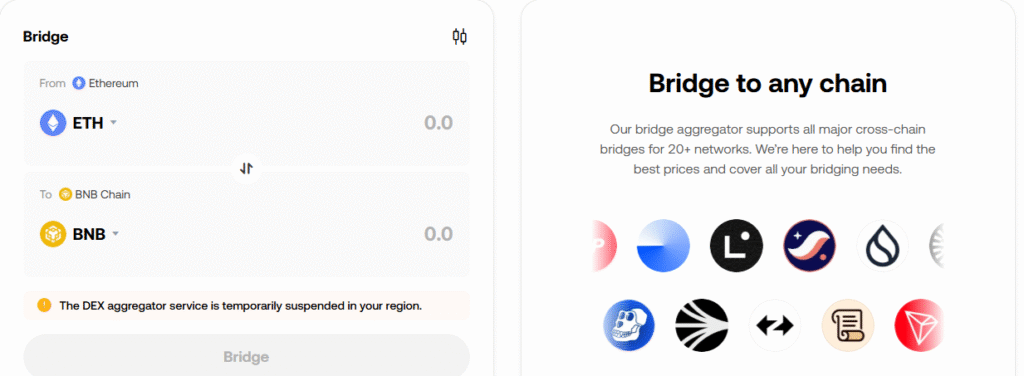In this article, I will cover strategies for managing bridging aggregator downtime and what proactive measures can be taken during such periods to reduce disruptions.
Cross-chain transfers may experience delays or complete halts whenever a bridging aggregator phases offline.
Understanding alternative methods and protective measures can greatly assist you in managing unexpected downtimes while ensuring the safety of your assets.
What is Bridging Aggregator?
A bridging aggregator is still a platform or tool with a robust performance enabling the merging of various blockchain recommendations. Users can transfer cross assets between blockchains in a more effective manner.

Instead of depending on a single bridge, a bridging aggregator utilizes all the available bridges to provide fast, secure, and cost-effective token transfer.
This user experience is enhanced by the reduction of fees, faster transfer times, and improved reliability in cross-chain transactions which is beneficial to the users.
How To Handle Bridging Aggregator Downtime?

Following the listed steps will allow you to cater to bridging aggregator downtimes quickly and effectively:
Marketer/Devs Check the Status: In the social accounts or official pages of the bridging aggregator, check for downtime or maintenance alerts.
Cross Check from Multiple Explorers: Using DeFiLlama or LayerZeroScan, verify if the issue is from the aggregator’s side or connected bridge’s side via aggregator specific explorers.
Supply Suspensions for Transactions: To mitigate loss of funds or stuck funds, do not initiate new bridging transactions with an aggregator during its downtime.
Make Use of An Alternative Bridge: Choose any standalone trusted bridge (such as Stargate, Hop, or Synapse) that accommodates both your source and destination chains manually.
Get in Touch with Support: Get in touch with aggregator support giving transaction hash, wallet address, and details of fund transfer.
Look Out for Recovery: Until when it goes back online look out so you know when services start again. Keep checking the status of transactions after connecting the aggregator in the online state.
Subsribe to Aggregator’s Alerts on Discord, Telegram, and Email for optional updates on ranger downtime: You can get future alerts about any downtime with discord, telegram, or email subscriptions in real time.
Immediate Steps to Take During Downtime
Here is what to do immediately when the bridging aggregator goes offline:
Pause all operations: Halt any bridging activities and plans to mitigate the risk of stuck funds.
Check the alongside aggregator communication offices: Look at their Twitter and Discord pages as well as their status page for relevant or maintenance updates.
Check the Wallet’s History: Go through your wallet to check if there are any pending transactions available.
Collect all relevant information: Take note of all relevant transactions including their hashes, timestamps, and wallet addresses for support purposes.
Change to Other Trusted Bridges: If the case is urgent, look for another pedestrian bridge, but ensure that it is trustworthy and matches your required networks.
How to Prepare for Future Downtime
To minimize the impact of future bridging aggregator downtimes, observe every step stated below to guarantee 100% accuracy.
Sign up for Alerts: Follow them on Discord, Telegram, or subscribe to their mailing list to instantly get notified about outages and maintenance notifications.
Learn The Other Options: Make a note of reliable stand alone bridges like Stargate or Synapse that operate on your regular chains and bookmark them.
Keep Some Liquidity in Different Chains: Have limited quantities of stable coins or primary gas tokens like ETH, MATIC etc. on certain blockchains where they can be accessed in an emergency.
Store Relevant Information: Take note of the transaction ID, bridge selection, wallet address, and contact details of the support in a secure note for easy access and retrieval.
Practice Direct Bridging: Be familiar with the use of independent bridges in the absence of an aggregator so as to be able to switch seamlessly between methods during down periods.
Avoid Critical Transfers During Peak Hours: Advise clients with non-urgent transfers to schedule them during times of low network congestion.
The steps listed above will assure that you are able to bridge gaps with eas and smoothness in times when aggregators are not in use, forcing dependencies on every task these aggregators facilitate.
Alternative Solutions During Downtime
Turning off a bridging aggregator does not mean that transactions have to come to a standstill. In fact, there are several ways of continuing to transfer assets across chains, even with the breaks in functionality:
Use Native Bridges Several blockchains now have their own native or official bridges, such as the Arbitrum Bridge, Polygon’s PoS Bridge, and the Optimism Gateway. Although these do not have the aggregation benefits, they tend to be much more reliable as they are maintained by the networks themselves.
Try Other Bridging Aggregators There are many bridging aggregators like Rango, Jumper Exchange, and Socket that could be operational while others are down. Always check the destination and source chains for compatibility before proceeding.
Leverage Centralized Exchanges (CEXs) While DeFi bridges are out of service, centralized exchanges such as Binance, Kraken, and Coinbase can still function as temporary bridges. These steps do involve more work and KYC, but the deposit and withdrawal are done through different chains.
Risk Management and Safety Tips
The following tips are crucial when it comes to risk management and ensuring safety while bridging on aggregators:
Begin With Minimal Transfers
Make sure to test with a minimal amount prior to transferring significant amounts across chains.
Confirm Chain and Token Info
Make sure that you are bridging the right token for the networks that are supported.
Keep An Eye On Transaction Confirmations
Monitor all steps in the bridging process through block explorers or aggregator dashboards.
Hardware Wallets Are Recommended
Protect your assets by bridging through secure wallets such as Ledger or Trezor.
Watch Out For Phishing Links
Access aggregate platforms strictly via their official portals which should be saved on bookmarks as opposed to haphazardly clicking on random links.
Inspect Bridge Fees and Slippage
Check these expenses in advance to avoid any unforeseen losses.
Stay Updated
Pay attention to the aggregator’s community channels for pertinent information like new updates, bugs, or possible scam alerts.
Conclusion
Bridging aggregator downtime handling requires patience, being considerate, and agile. Staying up to date through official sources, using native bridges or even centralized exchanges, and controlling risks, aids in minimizing disruptions to cross-chain transactions.
Always prepare for problems by diversifying your toolkit for tailored cross-chain transactions while prioritizing safety during unforeseen downtimes.









